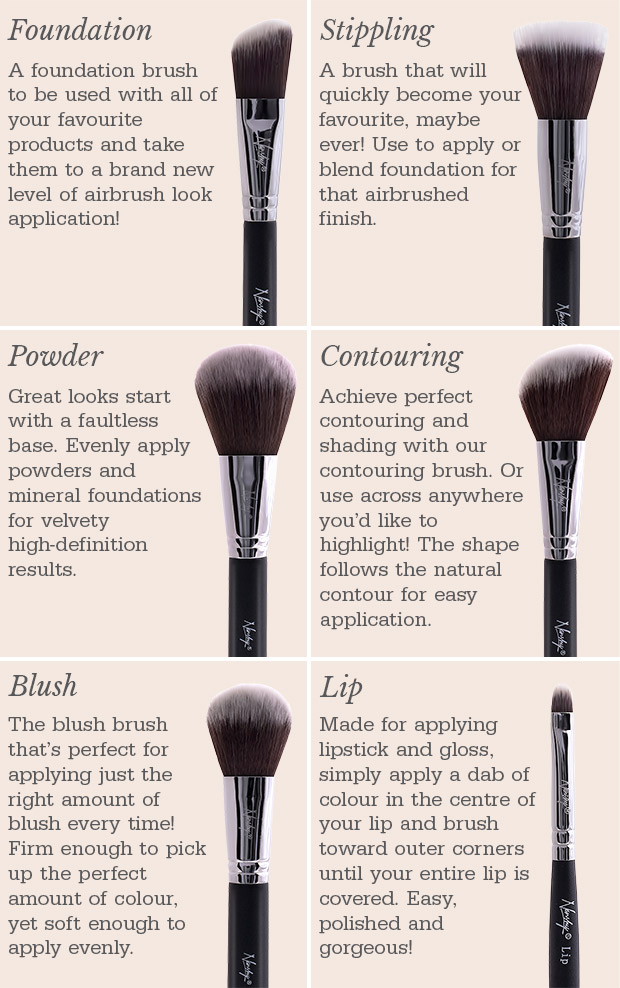

When I travel I save space by using one medium brush for contour and another medium brush for both blush and highlighter. You can use the same brush for all of these products as long as you clean it in-between, though for most it’s easier to have one brush per product category. The bristles fan out in a round shape, with either a very slight dome or a totally flat top. Ī kabuki brush generally refers to a brush with a smaller handle (though this is not mandatory) and a large head.

In a pinch, this can also allow you to apply blush or contour powder with the large brush. Tip: You can squeeze the bristles of the brush to get a narrower shape that will fit more easily along the sides of your nose. If you’ve overapplied powder, wipe the brush clean with a dry towel and then move it over your face in a circular buffing motion to remove the extra powder. Reload the brush with powder if necessary. If you were to swipe the brush over the face you would end moving your unset foundation around, potentially removing it or causing streaking. The reason for the tapping motion is that you want to press the powder into the face. Tap off the excess onto a tissue, and then use a tapping motion to apply the powder all over your face. To use: Swirl the brush in your powder container to load it up. Most powder brushes on the market these days are synthetic, though historically they used to be made of animal hair. The softer and more yielding the brush, the less heavy a layer of powder it will dispense, so it is perfect for setting makeup without having it look cakey or overly matte. High-quality powder brushes feel soft, fluffy and luxurious when they touch the skin, so using them can be one of the most pleasant parts of the makeup application process. The main difference between a dual-fiber and a flat-topped brush is that a dual-fiber brush is made of two types of bristles that are distributed evenly – there is a long layer of synthetic bristles and a shorter layer of natural bristles. īefore flat-topped makeup brushes popped on the market there was a brief period when dual-fiber brushes were the go-to makeup brushes for applying foundation seamlessly. Tip: You can also use the slightly domed/ pointed tip of this brush to get a fine line of contour cream under your cheekbone or along the side of your nose. Use a damp sponge to blend out any streaks or visible brush strokes.
HOW TO USE STIPPLING MAKEUP BRUSH SKIN
You can dispense foundation directly on the brush, and then tap it on the skin to transfer a large amount or drag it on in downward motions to sort of paint the skin with it. To use: If you do happen to own one of these makeup brushes you can still use it if you like. This type of brush has fallen out of favor in recent years because while it works for applying foundation it doesn’t blend it out, so a sponge is still necessary.

It is meant to be used sort of like a paint brush, with the flat side of the bristles coming in contact with the skin rather than the top of the bristles. It is a flat, synthetic brush with long, stiff bristles and a domed top. I think of this as the old-school foundation brush. To blend or sheer out your foundation, use a circular, buffing motion to move the product around your face. To achieve a higher coverage, use the brush in a tapping or stippling motion. To use: You can use a foundation brush either by dispensing a bit of foundation directly on it or by dotting the foundation on the face first and then using the brush to blend and buff it out. Some brands might refer to it as a buffing brush or even as a kabuki brush, although that’s not quite right.

This kind of brush applies cream and liquid foundations beautifully, with a seamless finish and without any lines or streaks.Īn oval foundation brush is actually just a variation on the typical flat-top foundation brush, with the main difference being the size of the head and the angle of the handle. The bristles themselves tend to be straighter and firmer than the bristles of a powder brush. It is a fairly large brush, though it is usually not as big as a powder or kabuki brush. The modern-day foundation brush is a stiff yet soft synthetic brush with a rounded head and a flat top. Once you understand the basics of the shape of each brush and which materials it works best with, you will find it easier to break these rules to achieve a makeup technique that works best for you. While some makeup brushes are better suited to some applications than others, consider this a loose guideline. I’m not a big believer in rules, especially considering just how much has changed in the makeup world since I went to makeup school.


 0 kommentar(er)
0 kommentar(er)
